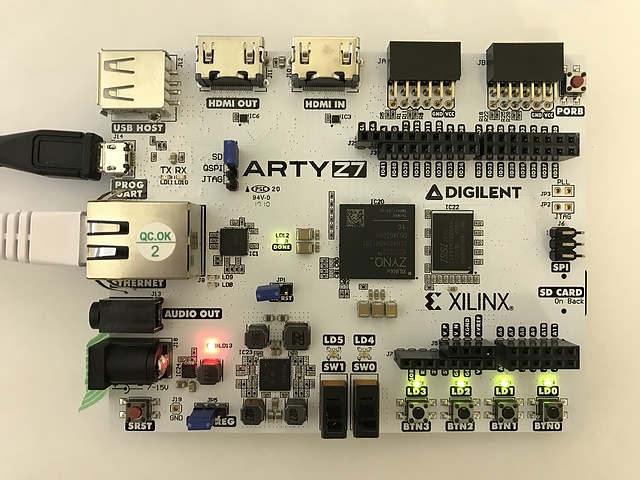Trial of python with Arty Z7, an FPGA board
category: make
tags: image
Summary
We can try image processing on the Intel’s FPGA Zynq easily using with the software pynq. Here we will try FPGA image processing using Digilent’s Arty Z7-20 which is easy to obtain instead of Zynq. Compared to Zynq, the Arty Z7-20 has the difference that there is no built-in microphone and there is no power switch. Originally Zynq and Arty Z7-20 are developed using Vivado and SDSoC which are development tools for FPGAs, but with pynq you can develop from python (Jupyter Notebook) which runs on web browser.

Preparation
- I have prepared an Arty Z7, miscroSD card with capacity of 8 GB or more, Ethernet connection (can assign the address by DHCP), micro USB power supply (the operating current was about 600-800 mA), and USB camera (if possible). Because the Zynq chip becomes hot while use, we may need heat sink on the chip.
- Download the image file from the pynq page and write it to the microSD card.
- Connect the microSD card, Ethernet cable, USB camera, and then connect the power supply.
- Access “http://IP address:9090” in the browser. The initial password is xilinx. ssh also works, both username and initial password can be accessed with xilinx.
- Try the image processing in the tutorial, such as transfer to FPGA.
Troubles I encountered…
- The MAC address changes frequently after power cycles. It is difficult to assign fixed IP address by DHCP.
- Browser dependent. I have encountered an error message “Can not connect kernel” with Firefox. Safari is OK.
- My Arty Z7 board cannot accept power supply from the DC plug (7 - 15 V) now, although I was able to use DC plug at first. I tried to resolve the problem with a tester and the circuit diagram, and I found the DC plug part is short-circuited. However the input of DC regulator IC TLV62130RGT is not short-circuited. I confused the situation.